The cultural tapestry of Uttarakhand, one can’t help but be mesmerized by the elegance and vibrancy of the Garhwali traditional dress.
Women adorn themselves in attire that echoes the region’s heritage and ethos. However, the cornerstone of this attire is the Ghagri, a flowing long skirt complemented by a choli and orni.
For special occasions, such as weddings, the attire blossoms into a symphony of colors and intricate designs. Lehengas, ghagras, and cholis dominate the bridal ensemble, often adorned with exquisite silver and gold tatting.
Particularly noteworthy are the Garhwali pichoras, resplendent in their traditional motifs, such as the revered Garuda symbol. This attire is not just a visual spectacle; it embodies profound cultural significance.
Additionally, the color scheme’s symbolic representation of purity and tranquility further underscores the deep-rooted connection to the Himalayan landscape.
Embracing the Garhwali traditional dress is not just about donning fabric; it’s about wearing a piece of heritage and history with pride.
1. Women’s Traditional Dresses

The traditional dress of women in the Garhwal region of Northern India, known as the Garhwali conventional dress, is steeped in cultural significance and practicality.
Typically, women adorn themselves in a sari, worn uniquely with the pallu draped from the front and knotted over the shoulder.
This method provides ease of movement and facilitates carrying essentials, especially during fieldwork. Historically, the sari was paired with a full-sleeved Angra (blouse) adorned with silver buttons for warmth.
However, women cover their heads with scarves to safeguard their hair and carry harvested goods. Married women accessorize with intricate silver ornaments, including the hansuli (necklace), guloband (choker), black beads, silver necklace called chareu, payal (anklets), dhagula (bracelet), and bichuye (toe rings).
The mandatory adornments include sindoor and bindi, symbolizing marital status. Notably, the guloband, typically crafted on a maroon or blue band with gold square pieces, remains a distinct symbol of matrimony. This attire embodies tradition, practicality, and cultural identity in the Garhwal region.
2. Hansuli
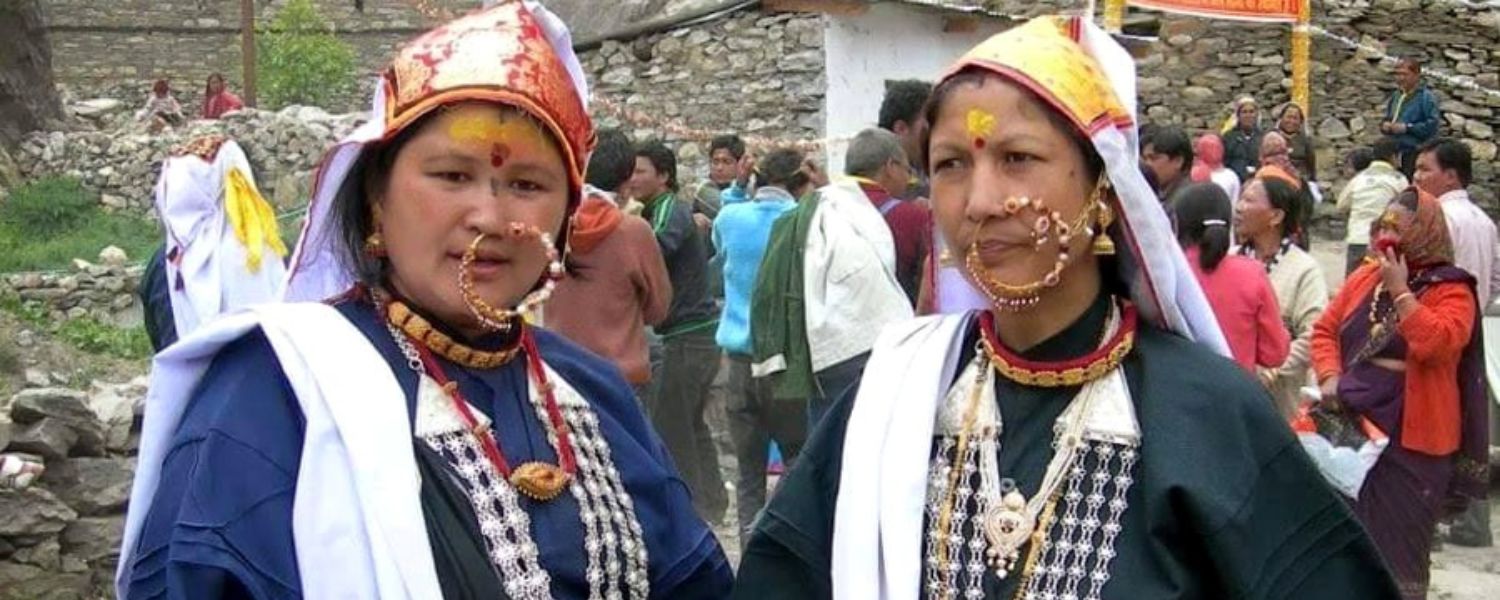
Hansuli, a key element of Garhwali traditional dress, embodies the region’s rich cultural heritage. This intricate jewelry holds profound significance, especially for newly married women.
Adorning the nose with a gold burqa is a cherished tradition, symbolizing marital status and prosperity. Passed down through generations, this custom underscores the importance of weddings in Garhwali communities.
The bride dresses splendidly during weddings, donning a vibrant red ghaghra complemented by opulent accessories. Among these adornments, the burqa takes center stage, alongside a magnificent nose ring known as nath, a maang teeka, and other ornate pieces crafted from precious gold.
Each accessory, including the silver kamar bandh, adds to the bride’s radiant beauty, accentuating the auspicious occasion with elegance and tradition.
3. Men’s Traditional Attire
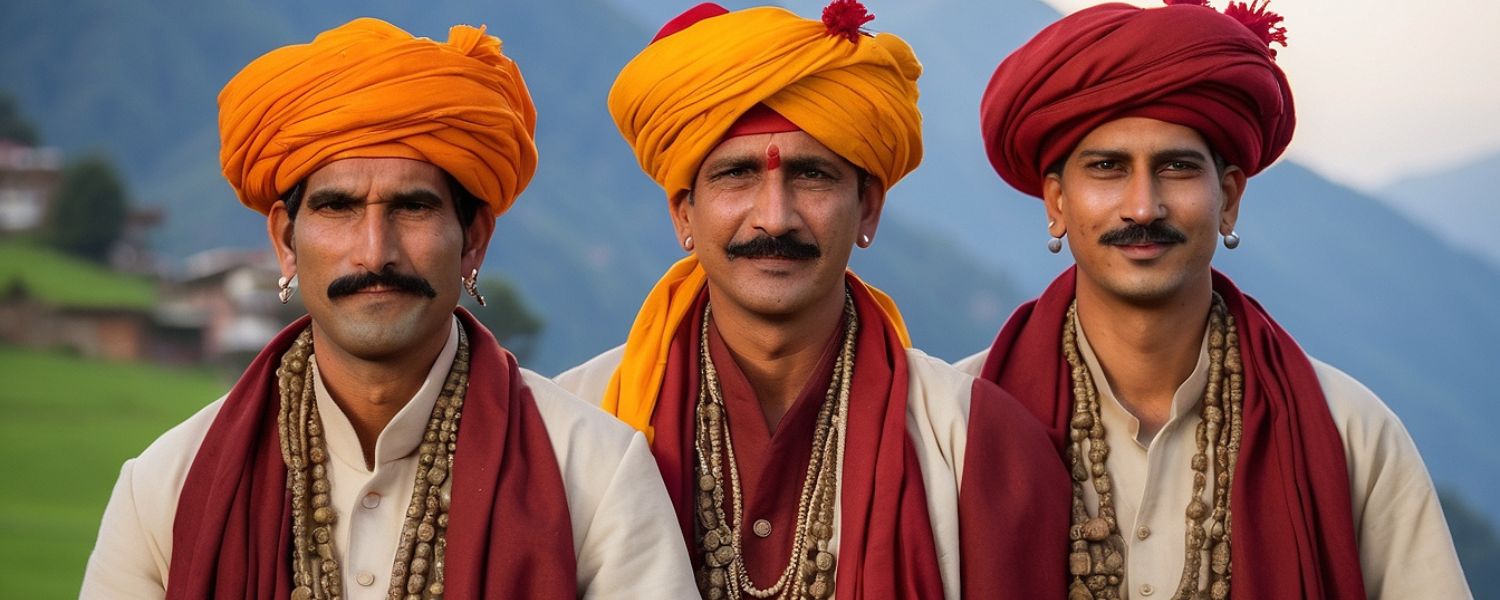
Garhwali traditional dress male embodies a rich tapestry of culture and history, reflecting the region’s unique identity. The quintessential attire comprises a kurta paired with either pajamas or churidar, tailored to suit different age groups.
A hallmark of Garhwali men’s clothing is the addition of a topi for the younger generation or a pagadi for the elders, serving as a fashion statement and offering protection from the chilly mountain weather.
While the influence of British culture introduced suits into the wardrobe, the preference for traditional garments persists, with fabrics varying according to the climate, from warm woolens to breathable cotton.
During auspicious occasions like weddings, the timeless combination of a yellow dhoti and kurta remains the favored choice for grooms.
Additionally, historical practices like safeguarding silver coins in a waist pouch, concealed beneath attire, reflect the pragmatic ingenuity of Garhwali Uttarakhand traditional dress male traversing the rugged terrains, and you can visit monuments of Uttarakhand.
4. Kumaoni Traditional Dresses
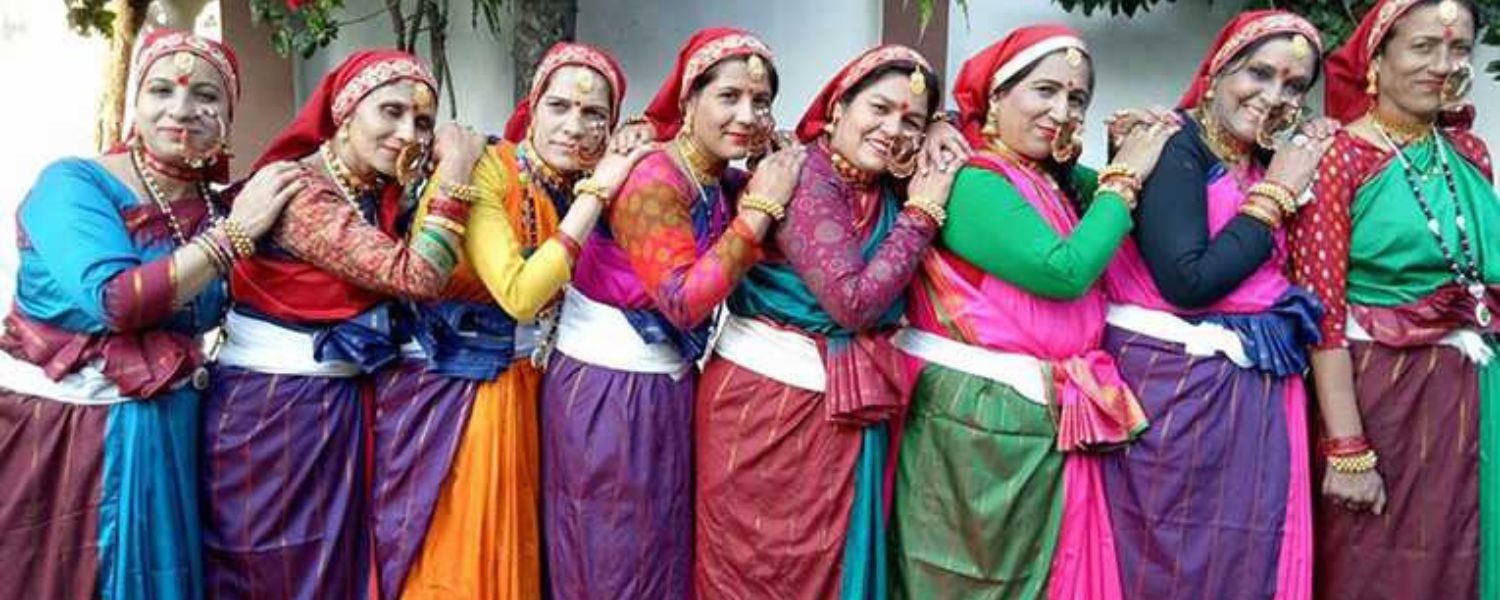
The traditional attire of women in the Kumaon region of Uttarakhand, particularly the Garhwali community, holds deep cultural significance and reflects the area’s rich heritage.
Typically, you’ll find them elegantly dressed in a traditional Garhwali dress, a ghagra paired with a kameez, resembling the attire worn by Rajasthani women.
Adding to their charm, kumaoni traditional dress women often adorn themselves with pichoras, a garment prominent during weddings and ceremonies, traditionally dyed yellow and crafted at home.
Even today, brides don this traditional pichora on their special day. Married garhwali dress females further embellish their attire with intricate gold maths covering their cheeks, hansuli, black beaded necklaces or charges, silver toe rings known as brochures, and sindoor, all considered essential adornments.
However, this traditional dress in Garhwali jewelry enhances their beauty and symbolizes marital status and cultural pride, epitomizing the grace and elegance of Garhwali traditions.
5. Jaunsaris
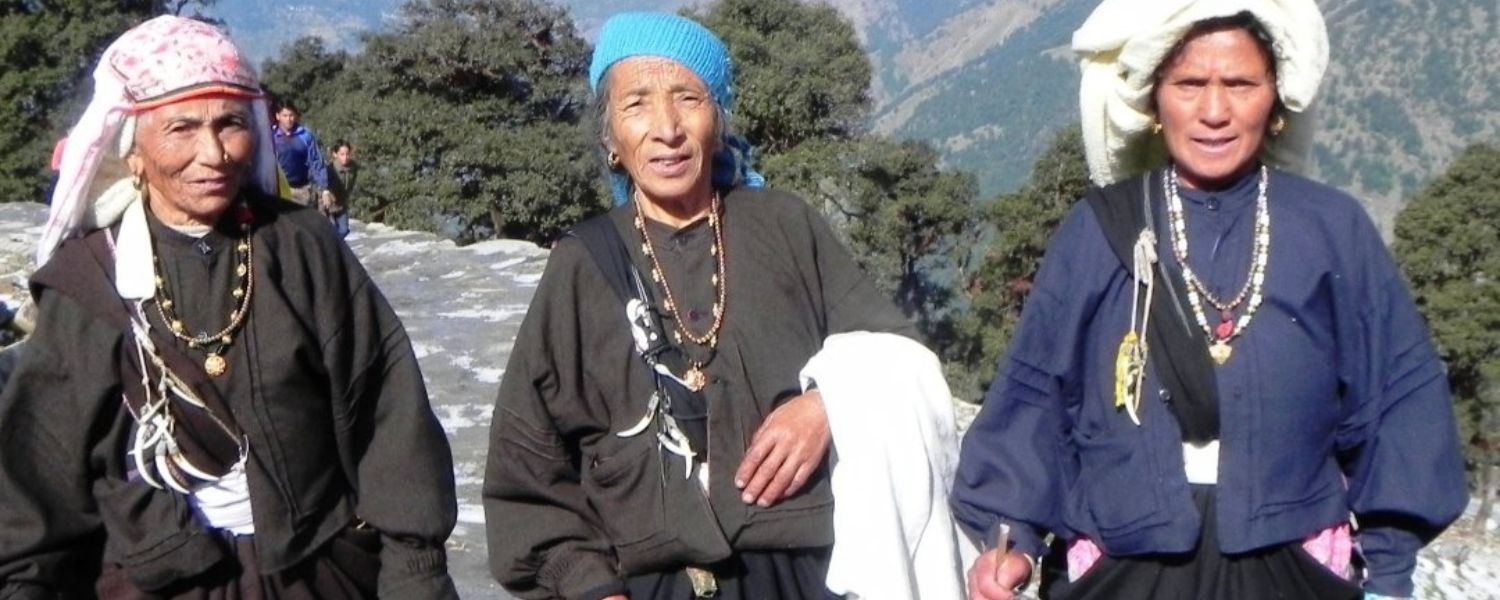
The Jaunsaris, a vibrant community nestled in the Garhwal region of Uttarakhand, boasts a rich cultural heritage intertwined with the legends of the Mahabharata. They proudly trace their lineage to the illustrious Pandavas, embodying a unique blend of tradition and splendor.
One of the most striking aspects of Jaunsari culture is their distinctive attire, which sets them apart from their Garhwali brethren.
Adorned in a kaleidoscope of colors and adorned with exquisite jewelry, both men and women don attire that reflects their rich heritage.
This includes intricately designed earrings, kadas, necklaces, and the signature digwa, a traditional woolen cap for men. Meanwhile, women grace themselves in elegant ghagras, warm woolen coats, and graceful dhantus (scarves).
During festive occasions, their attire reaches even greater heights of luxury with the addition of Thalkas or Lohiyas, long coats that further enhance their regal presence.
Through their clothing, the Jaunsaris express their cultural identity and pay homage to their storied past, creating a visual that captivates all who behold it.
6. Bhotia
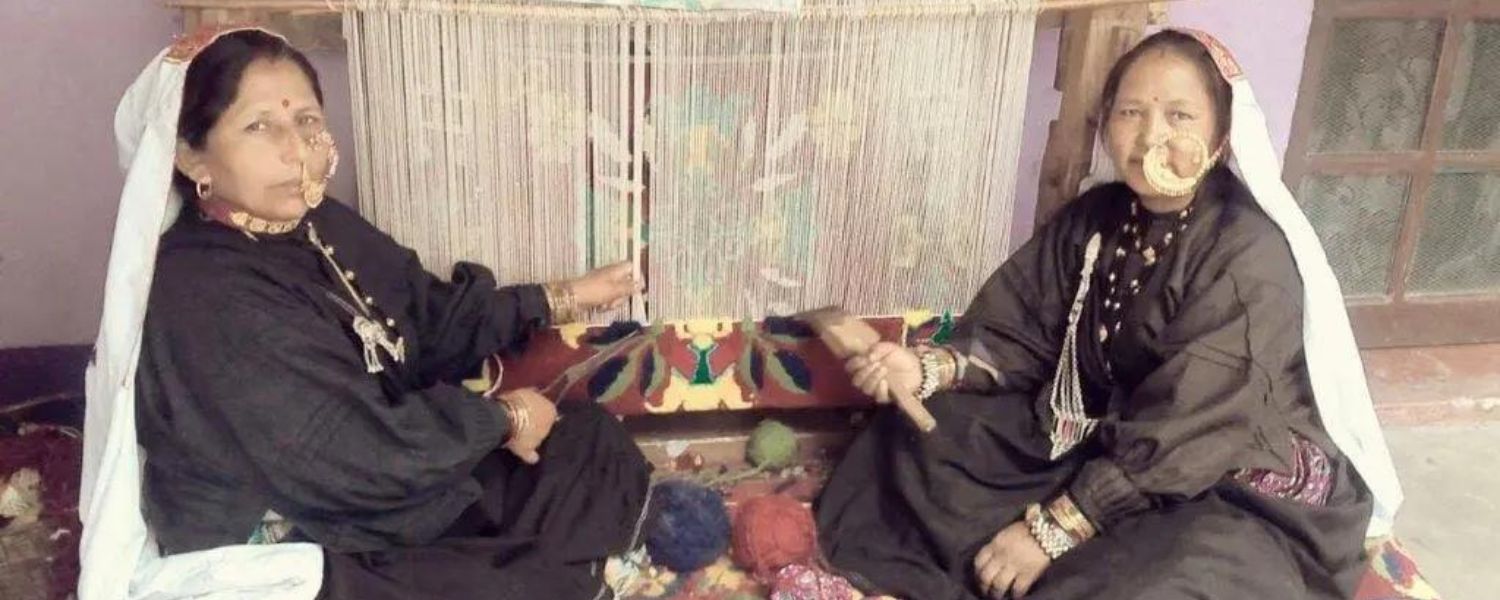
The Bhatia community, nestled in the lofty heights of the state’s chilly realms, epitomizes a harmonious blend of agriculture and pastoralism.
This Mongoloid ethnic group weaves a rich tapestry of tradition, both figuratively and literally, as they skillfully craft woolen yarn into snug garments to brave the biting cold.
Their attire is central to their cultural identity, a vibrant reflection of their heritage. Women grace themselves in a charming ensemble comprising a skirt, shirt, waistcoat, and coat while adorning their ears, necks, and noses with intricate gold or silver jewelry.
Meanwhile, men exude a rustic elegance, donning trousers layered with a loose gown secured by a woolen cloth known as a ‘patta,’ topped off with a warm woolen cap.
This attire encapsulates their pragmatic adaptation to the harsh mountain climes and is a poignant symbol of their cultural pride and resilience.
Indeed, the Bhotia’s traditional dress, akin to a colorful thread woven through the fabric of time, is a testament to their enduring spirit and heritage.
Conclusion
In conclusion, the Garhwali traditional dress is a proud emblem of Uttarakhand’s rich cultural heritage. Adorned with details and vibrant colors, this attire celebrates the region’s aesthetic beauty and embodies profound cultural significance.
From the flowing Ghagri skirts to the opulent bridal ensembles adorned with silver and gold tatting, each garment tells a story of tradition, resilience, and community.
As Garhwali women elegantly drape themselves in their Ghagris, adorned with essential accessories like the Bhansali and intricate silver ornaments, they carry the legacy of generations past.
Similarly, Garhwali men, clad in their kurta-pajama ensembles and distinctive topis or pagadis, exude a sense of cultural pride and sophistication.
Through their attire, the Garhwali people not only honor their heritage but also showcase the beauty and vibrancy of Uttarakhand’s cultural tapestry, making the Garhwali traditional dress a timeless symbol of identity and tradition in the heart of the Himalayas.
FAQ
Q. What is the traditional dress of Garhwal?
A. Garhwal’s traditional dress embodies a rich cultural heritage. Women adorn themselves in a Ghagri, a long skirt paired with a choli and orni.
For special occasions like weddings, elaborate attire such as lehengas, ghaghras, and cholis are worn, often embellished with intricate silver and gold tatting, known as ghagra pichora or Rangwali.
Q. Do Garhwali people wear pichora?
A. Yes, pichora holds significant cultural value among Garhwali women. It is traditionally gifted to brides and is an essential part of their attire on their wedding day. Over time, wearing pichora has become more prevalent in Garhwali culture.
Q. What is the tradition of Garhwal?
A. Garhwali tradition is deeply rooted in a close-knit community lifestyle. The region’s inhabitants, mainly Brahmins, uphold Hinduism as their predominant religion. Folk dances and music are integral components of Garhwali culture, reflecting the vibrant spirit of its people.
Q. What is the symbol of Garhwal?
A. The symbol of Garhwal is represented by two horizontal stripes of white and green, symbolizing purity, peace, and the verdant landscapes of the Himalayan state.
Additionally, the emblem features Garuda, the celestial vehicle of Lord Vishnu, symbolizing divinity and protection.










